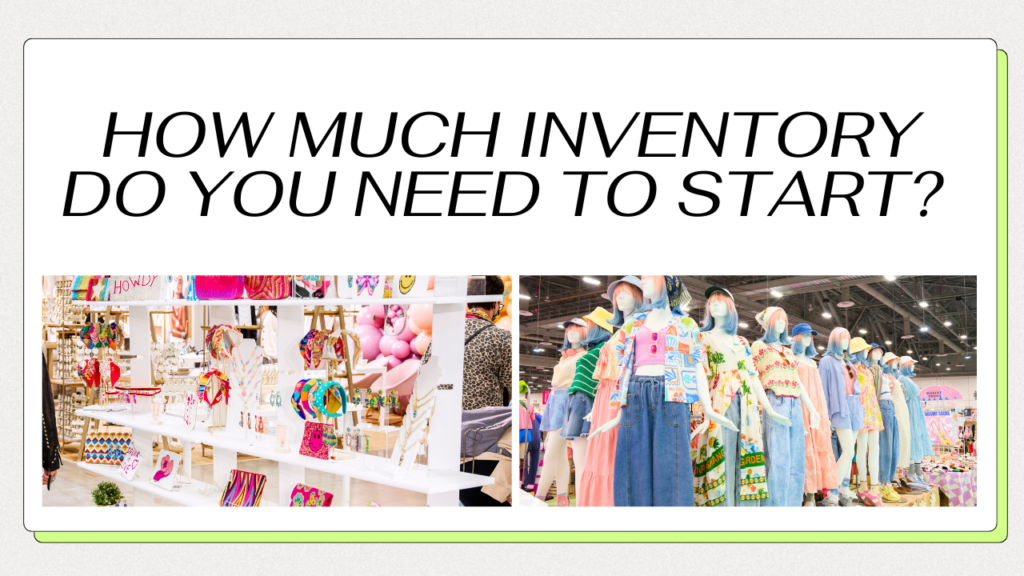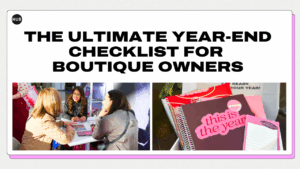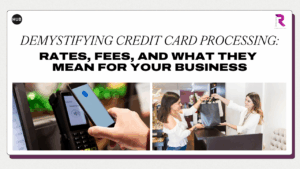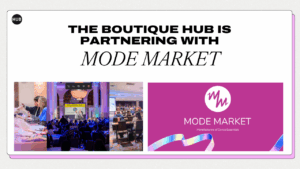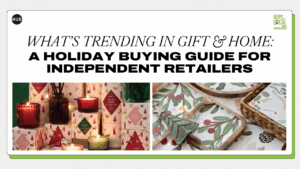Starting a boutique is an exciting venture, but one of the biggest questions new boutique owners face is: how much inventory do I need? The answer isn’t one-size-fits-all, as it depends on your business model, budget, and customer demand. However, having a strategic approach to inventory planning can set you up for success from day one.
Want an in-depth guide on determining the right amount of inventory to start with? Download our FREE guide here: How Much Inventory Do I Need to Start?
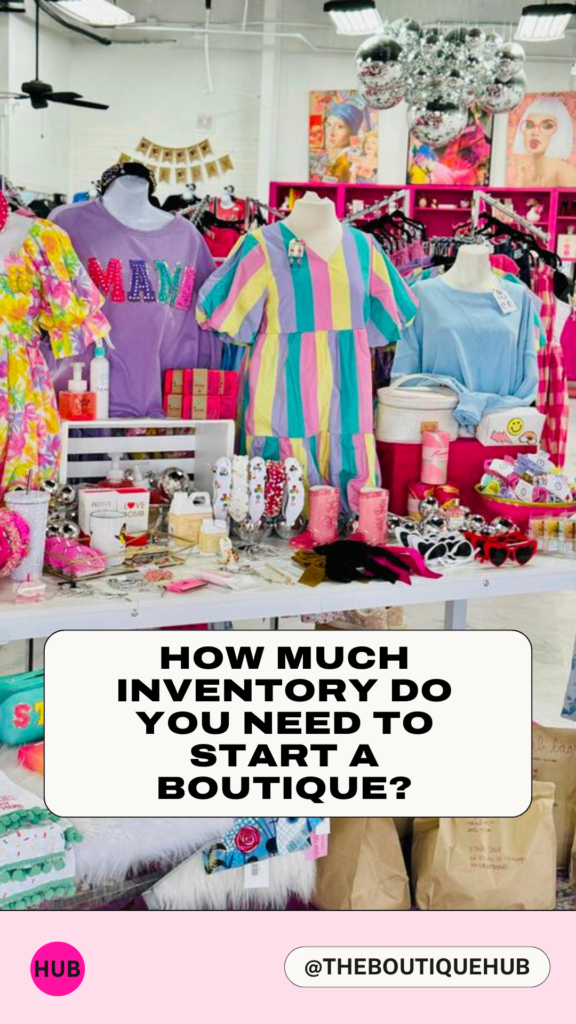
Factors to Consider When Buying Inventory
1. Your Boutique’s Business Model
- Brick-and-Mortar Boutique: If you’re opening a physical store, you’ll need enough inventory to fill your space without overwhelming it. A well-stocked boutique creates an inviting shopping experience, but too much inventory can lead to clutter and excess stock.
- Online Boutique: Without the constraints of a physical location, you can start with a smaller, curated selection. You may choose a pre-order or drop-shipping model to minimize upfront inventory costs.
- Pop-Up Shop or Market Events: If you’re selling at events or pop-ups, your inventory should be tailored to fit the theme, season, and expected foot traffic.
2. Determine Your Inventory Categories
To create a well-rounded boutique collection, start by breaking your inventory into key categories:
- Tops: Blouses, casual tops, sweaters, layering pieces, blazers
- Bottoms: Jeans, skirts, shorts, slacks
- Dresses: Casual, special occasion, seasonal, rompers
- Outerwear: Jackets, coats, vests
- Accessories: Scarves, hats, socks
- Jewelry: Necklaces, rings, bracelets
- Home Decor & Gifts: Candles, stationery, prints, baskets, journals, seasonal items
3. Establish an Inventory Breakdown
Where do you predict your sales to come from? A general rule for new boutiques is that 50% of your inventory should focus on the top half of the body, as these items tend to get more compliments and are easier to sell.
Here’s an example of a starting inventory budget allocation:
- Tops: 50%
- Jewelry: 15%
- Accessories: 15%
- Bottoms: 10%
- Outerwear: 5%
- Home Decor & Gifts: 5%
4. Start with Sales Projections
Estimate your first 3-6 months of sales based on expectations, market research, or similar businesses.
Use this formula to calculate projected monthly sales: Projected Monthly Sales = Average Order Value × Expected Foot Traffic or Online Orders
For example, if you expect 300 transactions per month at an average order value of $50, your projected monthly sales would be $15,000.
5. Determine Your Inventory Investment
Your starting inventory should be 2.5 to 3 times your projected monthly sales to ensure you have enough stock while allowing room for new arrivals.
For example, if your projected monthly sales are $30,000, your initial inventory should be valued at $75,000 – $90,000 at retail price. Depending on your markup, you can then determine your wholesale investment.
How to Avoid Overstocking
Buying too much inventory can tie up your cash flow and lead to markdowns. To prevent overstocking:
- Start with 1-2 packs per style and restock bestsellers.
- Use pre-order or waitlist strategies to gauge interest before making bulk purchases.
- Monitor sales trends and adjust your buying strategy accordingly.
Final Thoughts
Starting a boutique with the right amount of inventory requires a balance between variety and financial sustainability. Begin with a curated selection, track your sales, and adjust as needed. With strategic inventory planning, you can grow a successful boutique that keeps customers coming back for more!
Ready to take the guesswork out of inventory planning? Download our FREE guide here: How Much Inventory Do I Need to Start?
Need help sourcing inventory? Check out Hubventory for exclusive wholesale collections and trending styles perfect for your boutique!
Get more information on growing your business by joining The Boutique Hub where we have tons of training, strategies, and most importantly, connection! Try out our service for a month, cancel anytime.
- The Ultimate Year-End Checklist for Boutique Owners
 We are so excited to be bringing you some tips to make rolling into 2026 the smoothest transition yet! Here you will find our Boutique Owner’s End of the Year Checklist, filled with info on taxes, inventory, and more!
We are so excited to be bringing you some tips to make rolling into 2026 the smoothest transition yet! Here you will find our Boutique Owner’s End of the Year Checklist, filled with info on taxes, inventory, and more! - Demystifying Credit Card Processing: Rates, Fees, and What They Mean for Your Business
 Credit card processing can feel confusing, but it doesn’t have to be. This guide breaks down the different pricing models, explains what interchange fees actually are, and shows you how to calculate your true monthly processing cost so you can make smarter financial decisions for your business.
Credit card processing can feel confusing, but it doesn’t have to be. This guide breaks down the different pricing models, explains what interchange fees actually are, and shows you how to calculate your true monthly processing cost so you can make smarter financial decisions for your business. - The Boutique Hub to Deliver Retail Education at Mode Market 2026
 Mode Market 2026 is raising the bar for dance retailers everywhere. In an exciting new partnership with The Boutique Hub, the February event will now open with a full day of business education designed to help retailers boost sales, sharpen strategy, and build stronger brands. Taking place Wednesday, February 4, 2026, at the Henry B. González Convention Center in San Antonio, this collaboration blends Mode Market’s industry expertise with The Boutique Hub’s proven track record of empowering independent retailers. From mastering email marketing to optimizing in-store merchandising and turning local wins into online growth, attendees will gain the tools and insights needed to thrive in today’s ever-evolving retail landscape.
Mode Market 2026 is raising the bar for dance retailers everywhere. In an exciting new partnership with The Boutique Hub, the February event will now open with a full day of business education designed to help retailers boost sales, sharpen strategy, and build stronger brands. Taking place Wednesday, February 4, 2026, at the Henry B. González Convention Center in San Antonio, this collaboration blends Mode Market’s industry expertise with The Boutique Hub’s proven track record of empowering independent retailers. From mastering email marketing to optimizing in-store merchandising and turning local wins into online growth, attendees will gain the tools and insights needed to thrive in today’s ever-evolving retail landscape. - What’s Trending in Gift & Home: A Holiday Buying Guide for Independent Retailers
 Discover what’s trending in the gift and home industry with this Holiday Buying Guide for Home & Gift Retailers. In partnership with the Reps Are Local Too community, this guide highlights top holiday product trends, buying timelines, and merchandising ideas to help independent retailers plan inventory and maximize profits. Learn when to order, what to stock, and how to connect with local reps to keep your store ahead this season.
Discover what’s trending in the gift and home industry with this Holiday Buying Guide for Home & Gift Retailers. In partnership with the Reps Are Local Too community, this guide highlights top holiday product trends, buying timelines, and merchandising ideas to help independent retailers plan inventory and maximize profits. Learn when to order, what to stock, and how to connect with local reps to keep your store ahead this season. - The Boutique Hub at Vegas Fashion Week
 The Boutique Hub at Vegas Fashion Week We are so excited to announce that The Boutique Hub will be at Vegas Fashion Week! With so many sourcing opportunities, Vegas Fashion Week is a ‘must-attend’ event!
The Boutique Hub at Vegas Fashion Week We are so excited to announce that The Boutique Hub will be at Vegas Fashion Week! With so many sourcing opportunities, Vegas Fashion Week is a ‘must-attend’ event!
